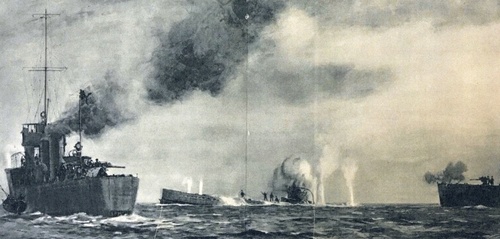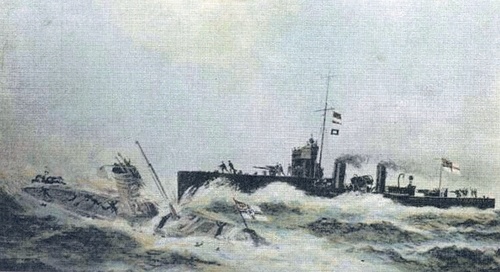Auction: 20001 - Orders, Decorations and Medals - conducted behind closed doors
Lot: 635
A Great War D.S.M. awarded to Petty Officer 1st Class G. Rodgers, Royal Navy, who was decorated when the destroyer Ariel rammed the submarine U-12 in the North Sea in March 1915 - significant as she had become the first submarine to launch an aircraft from her deck at sea
Distinguished Service Medal, G.V.R. (165462 G. Rodgers, P.O. 1Cl., H.M.S. Ariel.), nearly extremely fine
D.S.M. London Gazette 9 April 1915:
'For services in connection with the sinking of U.12.'
George Rodgers was born on 21 August 1875 at St. Paul, Chichester, the second son of publican Henry Rodgers and his wife Harriet of the Richmond Arms, Canal Wharf, Chichester, West Sussex. A wheelwright by trade, he enlisted into the Royal Navy as Boy 2nd Class on his eighteenth birthday and witnessed extensive training aboard St. Vincent and at the shore establishment Victory I in Portsmouth. Promoted Ordinary Seaman on 21 February 1895, Able Seaman aboard the corvette Cordelia on 1 July 1896, Leading Seaman aboard Duke of Wellington and Petty Officer 1st Class aboard the protected cruiser Sapphire on 1 May 1905, Rodgers witnessed steady promotion in the pre-war years, his conduct consistently noted as 'very good.'
Transferred to the destroyer Ariel on 7 February 1914, Rodgers was present on the morning of 10 March 1915 when the German submarine U-12 was spotted by the trawler May Island lurking to the east of Fife Ness on the lookout for any ships which dared venture out of the Firth of Forth. Having unsuccessfully failed to torpedo the ageing cruiser Leviathan whilst en route to Rosyth to pick up Vice Admiral George Patey, the new Commander in Chief, North America and West Indies Station (History of the Great War, by Julian Corbett, refers), the periscope of the U-12 was soon spotted by the Royal Navy destroyers Ariel, Acheron and Attack. The hunt was on!
Propelled at a top speed of 14.2 knots, U-12 attempted to escape to the south-east, following the craggy coastline of Dunbar, Cockburnspath and Coldingham. Pursued by the terrier-like destroyers, she was found at 10.15am half-submerged off the small Berwickshire fishing port of Eyemouth and strafed with machine-gun fire. Lacking a deck gun as a consequence of the space being previously employed by a Friedrichshafen FF.29 seaplane, the U-12 was unable to retaliate and instead attempted to submerge. As she slipped beneath the waves she was viciously rammed by Ariel who 'attempted to make effective use of her high speed' (The Dundee Courier, refers) and sliced the U-12's periscope clear off the conning tower.
Stopped in the water, the enemy was then shelled by Acheron and Attack. Of a compliment of 4 officers and 25 men, ten were able to escape through two deck hatches, but the others, including the Commander, Hans Kratzsch, went down with the vessel, unable to exit through the jammed conning tower hatch which had been struck square-on by Ariel.
The news of the demise of the U-12 was received with relief in the Admiralty and a 'long burst of applause' in the Court of the King's Bench Division (The Hull Daily Mail, refers). Having been responsible for sinking the British gunboat Niger at Deal on 11 November 1914, the U-12 had gone on to sink the cargo ship Aberdon off St. Abb's Head with the loss of 15 lives. Such was the success of the underwater menace that U-Boats were rapidly becoming seen as 'pirates' of the sea, or, in the words of Admiral Lord Beresford, they and their crews were the 'assassins of the sea.' The Dundee Courier summed up the loss of the U-12 in one word:
'Revenge!'
The crippled Ariel was towed back to Leith docks and spent the next few weeks under repair. Upon their capture, the surviving crew of the U-12 found themselves in the middle of a diplomatic row, with popular clamour in the press for stiff punishment beyond that extended to other prisoners of war. Kept in solitary confinement and denied any privileges of rank, the British Government determined to use them for means of propaganda. On 11 March 1915, the Dundee Courier stressed the humanity and aid offered by British sailors:
'After dealing the submarine its death blow, the Ariel maintained the traditions of the British Navy in giving succour to every possible member of its crew.'
Twelve days later, the Western Times attempted to stress to their heavily 'naval-based' readership the flagging morale within German submarine crews and the incompetence and coercion of the German Imperial Navy, by adding:
'An Irving man on board one of the destroyers that accounted for the ramming of the German submarine "U-12" writes in a letter home:
"The Germans were glad at being made prisoners by the British. They believe that Germany is now fighting a losing battle, and blame the Kaiser for the war. The men stated that they were doomed to die had they not been captured, for as soon as they put into Kiel with one submarine for repairs, they were forced at the muzzle of a revolver to board another and sent out to sea again. The coxswain of the sunken submarine had been a North Sea pilot for fifteen years, and knew the whole of the East Coast of Britain. At the beginning of the war he was put on board a submarine although he had never been on one of these vessels before.'
Irrespective of the propaganda battle, for one surviving member of the U-12 the adventure did not end with his capture. In September 1915, the U-12's pilot, Johann Volker, escaped from imprisonment at Maidenhead and made his way to Hull where he managed to board the Swedish vessel Jonstorp. In October, she was stopped in the North Sea by U-16, enabling Volker to join the U-Boat and return home to Germany; joining U-44 under Commander Paul Wagenfuhr, he was killed in action on 12 August 1917 when rammed by Oracle off South Norway. All the crew of 44 were lost, whilst Oracle suffered a similar fate to Ariel and had to be sent to Invergordon dry dock for repairs.
Awarded the D.S.M., Rodgers spent the remainder of the Great War at Portsmouth and aboard the battleship Hindustan from 18 September 1916-31 March 1917, and again from 27 April 1917-14 May 1918. As such, he was present in February 1918 when Hindustan was selected to serve as parent and depot ship during the Zeebrugge Raid and the first Ostend Raid. He also witnessed the collision of Hindustan and the destroyer Wrestler in May 1918, the former being paid off into reserve at the Nore on the day that Rodgers returned to Victory. Transferred to the shore establishment Fisgard, Rodgers was finally demobilised on 13 October 1918; sold with copied service record, newspaper articles and research.
Subject to 20% VAT on Buyer’s Premium. For more information please view Terms and Conditions for Buyers.
Sold for
£750
Starting price
£420







